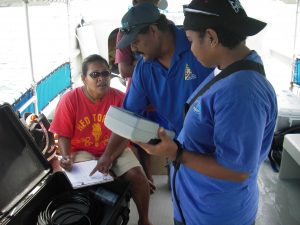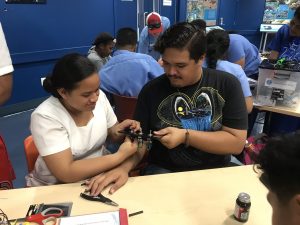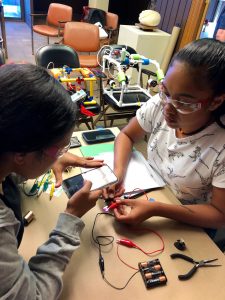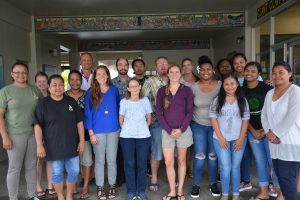
A proven tool for strengthening the technical capacity of the community colleges and the skills of faculty and students has been topical “footlocker” workshops, during which the participants are taught how to use tools and protocols to collect and analyze relevant data, and following the training exercises, the equipment, materials and supplies are packed into a footlocker to take back to the home institution for continued use.
Research: ocean acidification & extreme environments/conditions where corals survive.
Research: pairs with iSami-pH sensor (CTD measurements up to 120 mS/cm).
Application: In partnership with MATE, students build ROVs and learn/understand how/why an ROV works. Triggerfish has mechanical arm can be used to retrieve marine objects and camera to record marine species for identification.
Research: longterm monitoring of sediment runoff (turbidity) that impacts coral reef health; dissolved oxygen observations during algal blooms or other extreme events.
Research: coral reef bleaching, shoreline change, marine species identification, & reef damage.
Research: light intensity for coral health/bleaching.
Research: produce 3D coral images to observe structural changes.
Research: provides alternative ways to view science in 3D from organs in a human body to entire coral reef ecosystems.

The NSF ATE grant project has a strong informal science education outreach component, which increases an understanding of and appreciation for the value of STEM-focused education. A valuable benefit of the training local students is their ability to present information in the local languages. Hence, the model is clear: a central objective is to train islanders to address, research and respond to local STEM-related needs and issues. The students supported under this program will be expected to actively participate in community outreach activities.
Outreach resources are available for our NSF ATE faculty via a Google shared drive.

One of the goals of the ATE program are being accomplished by supporting regionally relevant curriculum development.
Existing and new technologies have been incorporated into college curricula and associated tools have been obtained and provided for use by the students, including sensors for pH/Ocean Acidification measurements and monitoring, underwater acoustic samplers for measuring parameters tied to larval recruitment and ecosystem health, and imaging infrastructure for measurements, modeling and analyses of sea level rise and coastal erosion.
Partnerships, like Stanford’s Center for Ocean Solutions and several of the Marine Laboratories that comprise the Western Association of Marine Laboratories (WAML) enhance research and training opportunities for the students as well as access to additional advanced technologies and broader data access for analyses.
Curricula resources are available for our NSF ATE faculty via a Google shared drive.

Much has been accomplished in the past 14 years, and the success of the NSF-ATE programs has led to a better appreciation of the importance of the community colleges in general, and STEM education in particular. The value and importance of the NSF funding cannot be overstated. For a relatively small investment of about $45,000 per year per institution we have documented 1) increased recruitment and retention in the regional community college marine and environmental sciences programs; 2) increased recruitment of Pacific Islanders into local resource agency, STEM-related research and educational positions; 3) increased matriculation of Pacific Islanders from 2 year programs into 4 year and graduate STEM degree programs; 4) improved preparation of community college faculty teaching marine and environmental sciences; 5) improved curricula that expose students to modern tools and technology; 6) expanded outreach efforts to local Pacific Island communities on the value of STEM to their qualities of life; and 7) enhanced regional cooperation among institutions of higher education in meeting their mandates.
Please contact us for specific document requests including but not limited to end of the year reports, published articles, and program summaries via powerpoint presentations or conference posters.